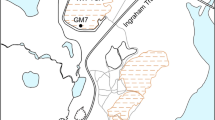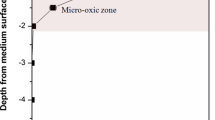Abstract
A characterization of the Shiprock, NM, uranium mill tailing site focused on the geochemical and microbiological factors governing in-situ uranium-redox reactions. Groundwater and aqueous extracts of sediment samples contained a wide concentration range of sulfate, nitrate, and U(VI) with median values of 21.2 mM, 16.1 µM, and 2.7 µM, respectively. Iron(III) was not detected in groundwater, but a median value of 0.3 mM in sediment extracts was measured. Bacterial diversity down gradient from the disposal pile reflected the predominant geochemistry with relatively high numbers of sulfate- and nitrate-reducing microorganisms, and smaller numbers of acetogenic, methanogenic, nitrate-dependent Fe(II)-oxidizing, Fe(III)-reducing, and sulfide-oxidizing bacteria. In aquifer slurry incubations, nitrate reduction was always preferred and had a negative impact on sulfate-, Fe(III)-, and U-reduction rates. We also found that sulfate-reduction rates decreased sharply in the presence of clay, while Fe(III)-reduction increased with no clear impact on U reduction. In the absence of clay, iron and sulfate reduction correlated with concentrations of Fe(III) and sulfate, respectively. Rates of U(VI) loss did not correlate with the concentration of any electron acceptor. With the exception of Fe(III), electron donor amendment was largely unsuccessful in stimulating electron acceptor loss over a 2-week incubation period, suggesting that endogenous forms of organic matter were sufficient to support microbial activity. Our findings suggest that efforts to accelerate biological U reduction should initially focus on stimulating nitrate removal.




Similar content being viewed by others
References
A Abdelouas Y Lu W Lutze HE Nuttall (1998) ArticleTitleReduction of U(VI) to U(IV) by indigenous bacteria in contaminated ground water. J Contam Hydrol 35 217–233 Occurrence Handle1:CAS:528:DyaK1cXnsFWksLc%3D
Anonymous (1996) Final programmatic environmental impact statement for the uranium mill tailings remedial action ground water project. US Department of Energy DOE/EIS-0198. http://www.doegjpo.com/gwwp/shp/shiprock.htm .
JB Baldensperger (1978) ArticleTitleAn iron-containing superoxide dismutase from the chemolithotrophic Thiobacillus denitrificans “RT” strain. Arch Microbiol 119 237–244 Occurrence Handle1:CAS:528:DyaE1MXhtFKqt7g%3D
LL Barton K Choudhury BM Thomson K Steenhoudt AR Groffman (1996) ArticleTitleBacterial reduction of soluble uranium: The first step of in situ immobilization of uranium. Radioact Waste Manag Environ Restorat 20 141–151 Occurrence Handle1:CAS:528:DyaK28XivVyrsb8%3D
R Brina AG Miller (1992) ArticleTitleDirect detection of trace levels of uranium by laser-induced kinetic phosphorimetry. Anal Chem 64 1413–1418 Occurrence Handle1:CAS:528:DyaK38XktF2nsbs%3D
ME Caldwell RS Tanner JM Suflita (1999) ArticleTitleMicrobial metabolism of benzene and the oxidation of ferrous iron under anaerobic conditions: Implications for bioremediation. Anaerobe 5 595–603 Occurrence Handle1:CAS:528:DC%2BD3cXhtFaks78%3D
Y Chang AD Peacock PE Long JR Shephen JP McKinley SJ MacNaughton AKM Anwar-Hussain AM Saxton DC White (2001) ArticleTitleDiversity and characterization of sulfate-reducing bacteria in groundwater at a uranium mill tailings site. Appl Environ Microbiol 67 3149–3160 Occurrence Handle1:CAS:528:DC%2BD3MXkvFSnu7w%3D Occurrence Handle11425735
FH Chapelle DR Lovley (1990) ArticleTitleRates of microbial metabolism in deep coastal plain aquifers. Appl Environ Microbiol 56 1865–1874 Occurrence Handle1:CAS:528:DyaK3cXktlOlsrw%3D
FH Chapelle DR Lovley (1992) ArticleTitleCompetitive exclusion of sulfate reduction by iron(III)-reducing bacteria: a mechanism for producing discrete zones of high-iron ground water. Ground Water 30 29–36 Occurrence Handle1:CAS:528:DyaK38XhtFejt7g%3D
JD Cline (1969) ArticleTitleSpectrophotometric determination of hydrogen sulfide in natural waters. Limnol Oceanogr 14 454–458 Occurrence Handle1:CAS:528:DyaF1MXksFegu70%3D
DA Elias LR Krumholz RS Tanner JM Suflita (1999) ArticleTitleEstimation of methanogen biomass by quantitation of coenzyme M. Appl Environ Microbiol 65 5541–5545 Occurrence Handle1:CAS:528:DyaK1MXnvVGjurg%3D Occurrence Handle10584015
DA Elias JM Senko LR Krumholz (2003) ArticleTitleA procedure for quantitation of total oxidized uranium for bioremediation studies. J. Microbiol. Meth. 53 343–353 Occurrence Handle1:CAS:528:DC%2BD3sXis12kur4%3D
AJ Francis CJ Dodge F Lu GP Halada CR Clayton (1994) ArticleTitleZPS and XANES studies of uranium reduction by Clostridium sp. Environ Sci Technol 28 636–639 Occurrence Handle1:CAS:528:DyaK2cXhslKjsbY%3D
R Ganesh KG Robinson GD Reed GS Sayler (1997) ArticleTitleReduction of hexavalent uranium from organic complexes by sulfate- and iron-reducing bacteria. Appl Environ Microbiol 63 4385–4391 Occurrence Handle1:CAS:528:DyaK2sXnt12nt7Y%3D
YA Gorby DR Lovley (1992) ArticleTitleEnzymatic uranium precipitation. Environ Sci Technol 26 205–207 Occurrence Handle1:CAS:528:DyaK38XhtV2ltg%3D%3D
V Gruntzig SC Nold J Zhou JM Tiedje (2001) ArticleTitle Pseudomonas stutzeri nitrite reductase gene abundance in environmental samples measured by real-time PCR. Appl Environ Microbiol 67 760–768 Occurrence Handle1:CAS:528:DC%2BD3MXhtFSls7g%3D Occurrence Handle11157241
DE Holmes KT Finneran RA O’Neil DR Lovley (2002) ArticleTitleEnrichment of members of the family Geobacteraceae associated with stimulation of dissimilatory metal reduction in uranium-contaminated aquifer sediments. Appl Environ Microbiol 68 2300–2306
IA Ivanova JR Stephen Y Chang J Brüggemann PE Long JP McKinley GA Kowalchuk DC White SJ Macnaughton (2000) ArticleTitleA survey of 16S rRNA and amoA genes related to autotrophic ammonia-oxidizing bacteria of the beta-subdivision of the class proteobacteria in contaminated groundwater. Can J Microbiol 46 1012–1020 Occurrence Handle1:CAS:528:DC%2BD3cXotFait7c%3D Occurrence Handle11109489
BE Jackson MJ Mclnerney (2002) ArticleTitleAnaerobic microbial metabolism can proceed close to thermodynamic limits. Nature 415 454–456 Occurrence Handle10.1038/415454a Occurrence Handle1:CAS:528:DC%2BD38XhtVKjsrY%3D Occurrence Handle11807560
MPM Janssen (1993) ArticleTitleBiomagnification of metals in terrestrial ecosystems. Sci Total Environ Supp 1–511
GM King (1984) ArticleTitleUtilization of hydrogen, acetate, and “noncompetitive” substrates by methanogenic bacteria in marine sediments. Geomicrobiol. J. 3 275–306 Occurrence Handle1:CAS:528:DyaL2cXlsVOgtL8%3D
D Langmuir (1997) Aqueous Environmental Geochemistry. Prentice Hall Saddle River, NJ 496–500
DR Lovley JD Coates (1997) ArticleTitleBioremediation of metal contamination. Curr Opin Biotechnol 8 285–289 Occurrence Handle1:CAS:528:DyaK2sXjvFSqur0%3D Occurrence Handle9206008
DR Lovley EJP Phillips (1987) ArticleTitleRapid assay for microbialy reducible ferric iron in aquatic sediments. Appl Environ Microbiol 53 1536–1540
DR Lovley EJP Phillips (1988) ArticleTitleNovel mode of microbialy energy metabolism: Organic carbon oxidation coupled to dissimilatory reduction of iron or manganese. Appl Environ Microbiol 54 1472–1480
DR Lovley EJP Phillips (1992) ArticleTitleReduction of uranium by Desulfovibrio desulfuricans. Appl Environ Microbiol 58 850–856 Occurrence Handle1:CAS:528:DyaK38Xhs12rtbo%3D Occurrence Handle1575486
DR Lovley EJP Phillips YA Gorby ER Landa (1991) ArticleTitleMicrobial reduction of uranium. Nature 350 413–417 Occurrence Handle1:CAS:528:DyaK3MXitVegsb8%3D
DR Lovley EE Roden EJP Phillips JC Woodward (1993) ArticleTitleEnzymatic iron and uranium reduction by sulfate-reducing bacteria. Mar Geol 113 41–53 Occurrence Handle1:CAS:528:DyaK2cXhvFKhu78%3D
JP McKinley JM Zachara S Smith GD Turner (1995) ArticleTitleThe influence of uranyl hydrolysis and multiple site-binding reactions on adsorption of U(VI) to montmorillonite. Clays Clay Miner 43 586–598 Occurrence Handle1:CAS:528:DyaK28XhtFSjsLs%3D
A Mohagheghi DM Updegraff MB Goldhaber (1984) ArticleTitleThe role of sulfate-reducing bacteria in the deposition of sedimentary uranium ores. Geomicrobiol. J. 4 153–173
JM Senko JD Istok JM Suflita LR Krumholz (2002) ArticleTitleIn-situ evidence for uranium immobilization and remobilization. Environ Sci Technol 36 1491–1496 Occurrence Handle1:CAS:528:DC%2BD38XhsFaitLw%3D Occurrence Handle11999056
RL Smith (2002) Determining the terminal electron-accepting reaction in the saturated subsurface. CJ Hurst (Eds) Manual of Environmental Microbiology, 2nd ed. American Society for Microbiology Washington, DC 743–752
PH Sneath VB Skerman (1966) ArticleTitleA list of type and reference strains of bacteria. Int J Syst Bacteriol 16 1–133
W Stumm JJ Morgan (1996) Oxidation and reduction; equilibria and microbial mediation. Chapter 8 in: Aquatic Chemistry: Chemical Equilibria and Rates in Natural Waters, 3rd ed. John Wiley & Sons New York 425–513
T Sugio KJ White E Shute (1992) ArticleTitleExistence of a hydrogen sulfide: ferric ion oxidoreductase in iron-oxidizing bacteria. Appl Environ Microbiol 58 431–433 Occurrence Handle1:CAS:528:DyaK38Xht1Cms7k%3D
RS Tanner (1996) Monitoring sulfide and sulfate-reducing bacteria. Proceedings of the Fifth International Conference on Microbially Enhanced Oil Recovery and Related Biotechnology for Solving Environmental Problems. NTIS Springfield, VA
BM Tebo AY Obraztsova (1998) ArticleTitleSulfate-reducing bacterium grows with Cr(VI), U(VI), Mn(IV), and Fe(III) as electron acceptors. FEMS Microbiol Lett 162 193–198 Occurrence Handle1:CAS:528:DyaK1cXisFalt7s%3D
GA Ulrich D Martino K Burger J Routh EL Grossman JW Ammerman JM Suflita (1998) ArticleTitleSulfur cycling in the terrestrial subsurface: Commensal interactions, spatial scales, and microbial heterogeneity. Microbial Ecol 36 141–151 Occurrence Handle1:CAS:528:DyaK1cXlsVOnurY%3D
NM vanStraalen W Ernst (1991) ArticleTitleMetal biomagnification may endanger species in critical pathways. Oikos 62 255–257
C White JA Sayer GM Gadd (1997) ArticleTitleMicrobial solubilization and immobilization of toxic metals: key biogeochemical processes for treatment of contamination. FEMS Microbiol Rev 20 503–516 Occurrence Handle1:CAS:528:DyaK2sXltl2msb8%3D Occurrence Handle9299717
Acknowledgements
We thank John Senko for analysis of uranium samples. Support of the US Department of Energy, Office of Science, Biological and Environmental Research under the Natural and Accelerated Bioremediation Research (NABIR) Program is gratefully acknowledged. The cooperation of the US Department of Energy Uranium Mill Tailings Remedial Action (UMTRA) Program was crucial to the success of this research.
Author information
Authors and Affiliations
Corresponding author
Rights and permissions
About this article
Cite this article
Elias, D., Krumholz, L., Wong, D. et al. Characterization of Microbial Activities and U Reduction in a Shallow Aquifer Contaminated by Uranium Mill Tailings . Microb Ecol 46, 83–91 (2003). https://doi.org/10.1007/s00248-002-1060-x
Received:
Accepted:
Published:
Issue Date:
DOI: https://doi.org/10.1007/s00248-002-1060-x




